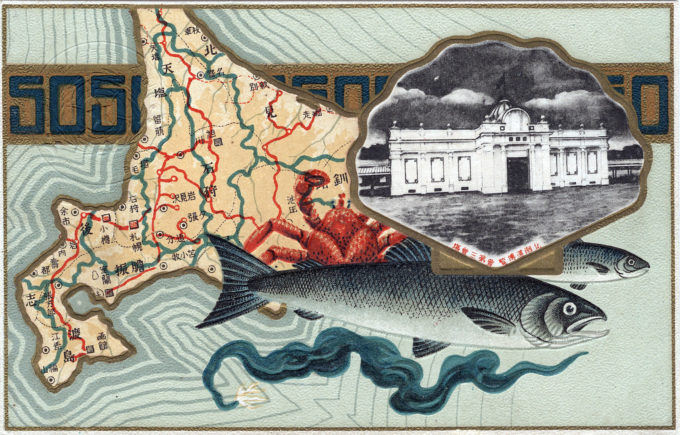
Hokkaido Semi-Centennial Exposition, 1918. The celebration, the 50th anniversary of Hokkaido’s “opening”, was held at Nakajima Park in Sapporo.
See also:
Sheep grazing in the shadow of Ezo Fuji, Hokkaido, c. 1930.
“The Five Stock Exhibition of Hokkaido,” c. 1920.
“‘American Influence in Japan’ is a broad topic, one aspect of which was impressed upon me in a recent trip to the northern island of Hokkaido.
“The occasion was the Semi-Centennial Exposition at Sapporo (the capital of Hokkaido) organized to celebrate the semi-centenary (by the Japanese inclusive method of counting) of the ‘opening’ of Hokkaido in 1869. It was then, just after the revolution which restored the executive authority to the Emperor, that the island of Yezo was renamed ‘Hokkaido’ (Northern Sea Road) and placed under a special administration.
“The administrative body of the new-old ‘territory’ was called Kaitakushi, which means literally ‘opening-settling-commission.’ The chief commissioner, or ‘governor,’ was General Kiyotaka Kuroda, a man of vision; he not only discovered the unexpected resources of the island (which had been a terra incognita), but also foresaw its great possibilities. He found the soil fertile and the country immensely rich in natural resources. The greatest need was for development, and that required not merely men but also wisdom. He therefore visited America in 1870-1871 and studied American success in ‘opening up’ the Western states.
“… In accordance with General Kuroda’s [recommendations], General Horace Capron, then Commissioner of Agriculture in Washington, D.C., came to Japan as adviser to the Colonial Office … And, during the next decade, General Kuroda invited from abroad seventy-five persons, of whom forty-five were Americans. Among them were Colonel Crawford, an American engineer, who, among other achievements, constructed the first railroad line in Hokkaido.
“The most extensive and intensive piece of work of these Americans was the establishment of an agricultural college in Sapporo. To that institution came Dr. W.S. Clark, then President of the Massachusetts Agricultural College, lent to japan for only one year. In that short period, however, he made a lasting impression upon Japan and the Japanese.
“American influence was manifested even in the laying out of Sapporo, the new capital … It was General Capron who advised the Japanese to build solid and substantial dwelling-houses after the American style, with window-panes instead of the paper windows still commonly used in Japan.
“The farms of Hokkaido also had Americanized building; and they raised crops of American grains, grasses, vegetables, and fruits, and used American agricultural machines. It was Americans, too, who introduced live-stock breeding and dairying … The agricultural methods of Hokkaido were at first nothing but the American system in miniature.”
– “American Influence in Japan”, by Ernest W. Clement, The Nation, November 9, 1918


Pingback: “Hokkaido Imperial University”, Sapporo, c. 1920. | Old TokyoOld Tokyo